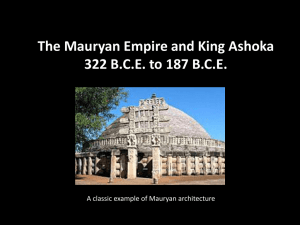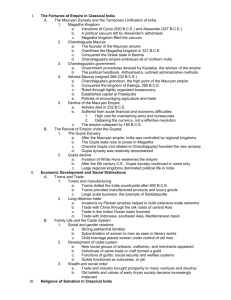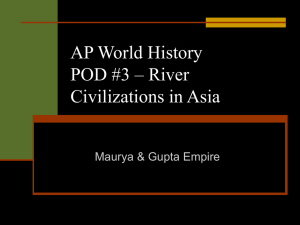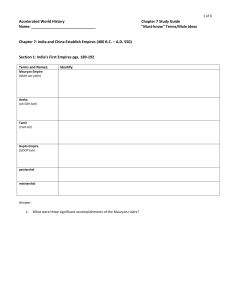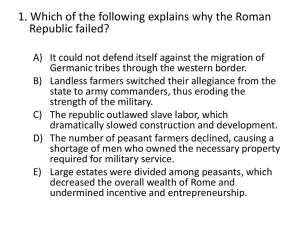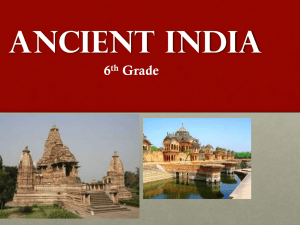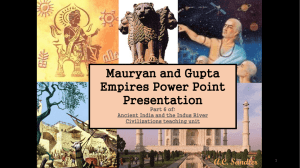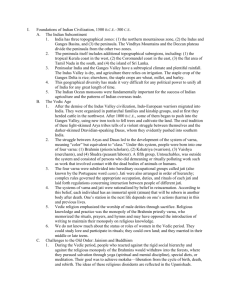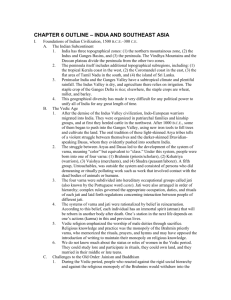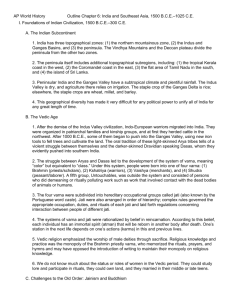Period 6: 600 B.C.E- 600 C.E
advertisement
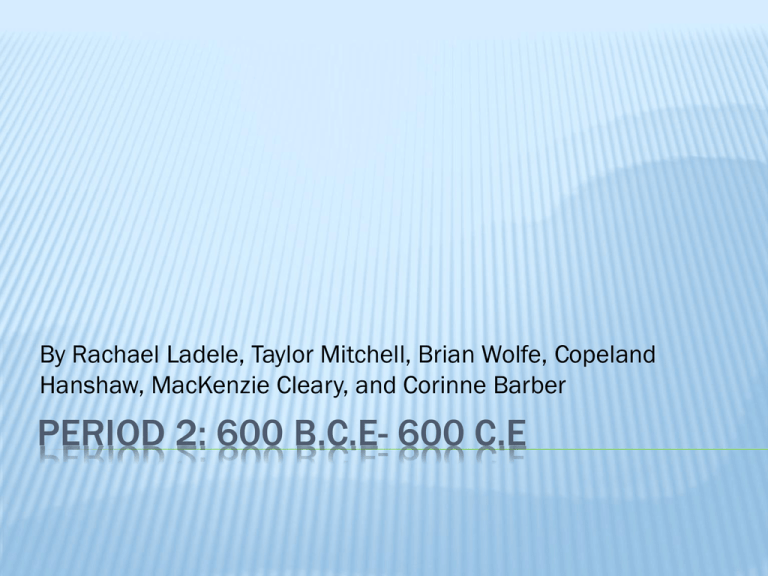
By Rachael Ladele, Taylor Mitchell, Brian Wolfe, Copeland Hanshaw, MacKenzie Cleary, and Corinne Barber PERIOD 2: 600 B.C.E- 600 C.E GEOGRAPHICAL SNAPSHOTS GEOGRAPHICAL SNAPSHOTS GEOGRAPHICAL SNAPSHOTS Rome S: Social orders were established in Rome. The Patricians were the wealthier of the two. The Patricians were upper class while the Plebians were considered low class. The Senate was made up of Patricians while the Assembly was made up generally of Plebians. P: “Innocent until proven guilty” originated in the Roman Judicial system. On court issues, not everyone had to vote. Instead, they elected representatives to make the decision. GEOGRAPHICAL SNAPSHOTS R: After the reign of Augustus Caeser, Christianity began to develop within the Roman Empire. The Roman powers used to see Christianity as a threat because they had set rules and expectations for their people and did not like them getting new ideas and feeling equal to higher powers. I: The Pax Romana was “Roman Peace” and that is when they didn’t focus so much on military power but put more interest in arts, science, and math. Since they weren’t spending so much on the military, they had more money to invest in intellectual Rome. GEOGRAPHICAL SNAPSHOTS T: Romans made a large contribution to the technology in the world during the 2nd period. They introduced structures like the aqueduct that carried water from higher elevation to lower. This made it easier to get water to civilizations and also helped agriculture. E: As the Roman empire declined economically, small landowners were frequently forced to sell their land to the owners of large estates. The economic self-sufficiency of the estates discouraged trade among the various parts of the empire. The decline in trade eventually produced a decline in urban population. GEOGRAPHICAL SNAPSHOTS Han China S: The emporer was the highest authority in the Han society and government. Even still, the emporer was often ruled over by the empress or one of her male relatives. The rank below emporer were the kings. Below that is the nobles and then slaves. P: After 92 CE, the palace eunuchs increasingly involved themselves in court politics, engaging in violent power struggles between the various clans of the empresses and empress, eventually leading to the Han’s downfall. GEOGRAPHICAL SNAPSHOTS R: Daoism gained a new popularity during the 2nd period. In 184, the Yellow Turbans, a Daoist revolutionary movement, promised a new age of prosperity and security. Buddhism was also spread as Chinese cultural unity was dissolving. I: The imperial examination was an examination system in Imperial China designed to select the best administrative officials for the states’ bureaucracy. This system had a large influence on both society and culture in Han China. GEOGRAPHICAL SNAPSHOTS T: The Han Dynasty invented the ban liang coin type. In the beginning of the Han, Emporer Gaozu closed the government mint in favor of private minting of coins. Later his widow Grand Empress Lu Zhi abolished private minting giving rise to the ban liang coin type. E: The invention of coins for currency in the early 6th century BCE was a significent development for the economy because it made trade easier and also made it easier to value trade items based on the value of the currency. Coins were generally made of silver, gold, or bronze. The invention of coins stimulated trade and increased the total wealth of the society. CHANGE OVER TIME 1. o - - - South Asia The Mauryan Empire in India (321- 180 B.C.E) Chandragupta Maurya founded the Mauryan Empire, and he unified the smaller Aryan kingdoms into a civilization. His grandson, Ashoka Maurya, took the civilization to new heights. This empire became very powerful because of trade in which they traded silk, cotton, elephants to Mesopotamia and Eastern Roman empire. Also, their military was very strong. Ashoka saw the military in the battles, and converted to Buddhism and preached non-violence, and moderation. -Example: Rock and Pillar Edicts After Ashoka’s death in 232 B.C.E, the empire declined due to economic problems and pressure from attacks in the northeast. CHANGE OVER TIME The Gupta Dynasty in India (320-550 C.E) o After the death of Ashoka, and the decline of the Mauryan, Chandra Gupta created the Gupta Empire. - The empire was more decentralized and smaller. - It was referred to as a golden age because it enjoyed relative peace and saw significant advances in the arts and sciences. - The Gupta Dynasty renewed Hinduism to become the dominant religion in India. -Hinduism also brought back the caste system which lowered women’s rights. The Gupta Dynasty fell because they were under pressure from the White Huns in 550 C.E. 2. CHANGE OVER TIME SPRITE o o - Analysis Social : Urbanization Patriarchal Societies Political: Community Planning Mauryan and Gupta Dynasties Religion: Buddhism Hinduism - Intellectual: - Concepts of pi&zero - Arabic numerals - Technological: -same as Intellectual - Economic: -grains - Indian Ocean Trade CHANGE OVER TIME Changes - Hinduism and Buddhism: As the Mauryan Empire fell, Buddhism became less - - popular, while Hinduism rose to its amount of followers in the Gupta Empire. Caste system: When Hinduism was reinforced it also brought back the caste system which lowered women's rights. Dynasties: Mauryan- big civilization with a powerful system of trade, and military, and used Buddhism as their main religion Gupta- smaller, decentralized, and had Hinduism as their main religion. Continuities - Active Trade: The Indian Ocean Trade was very popular in this time period. It sent spices, tropical fruits, pearls, etc. to Southeast Asia, East Africa, and the Middle East. The monsoon winds controlled the trade routes. COMPARE AND CONTRAST Compare Greece and Rome Social status of women class separation slaves = important part of society Political city states representative governments only adult males in politics Religious polytheistic Intellectual Golden age v. Pax Romana COMPARE AND CONTRAST Greece – Rome Political – Democracy Technological – Not agriculturally advanced because of mountains Dependent of rainfall Republic Tenant farmers Emphasis on unifying laws Colosseum = political (and social) display of power Aqueducts and roads

